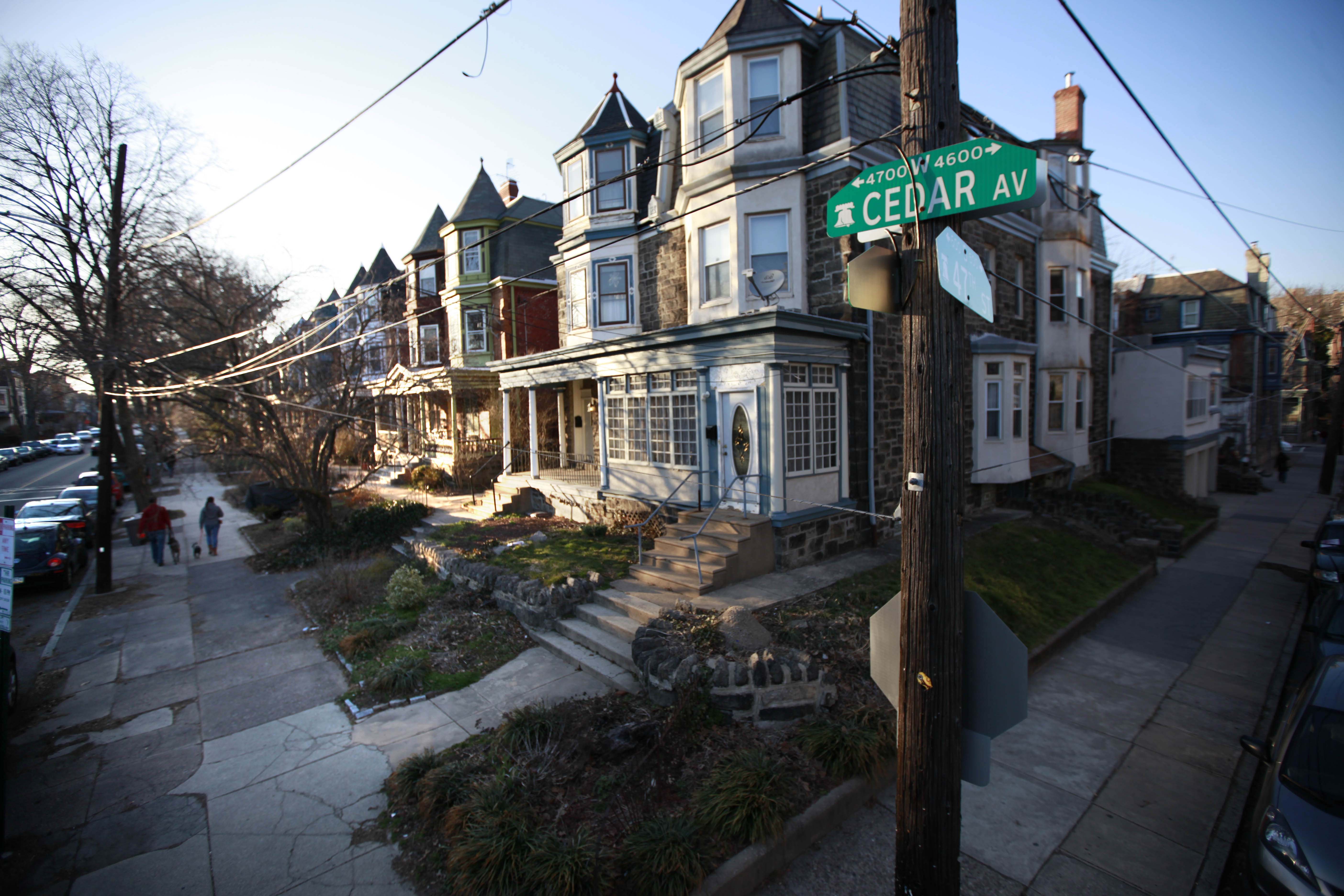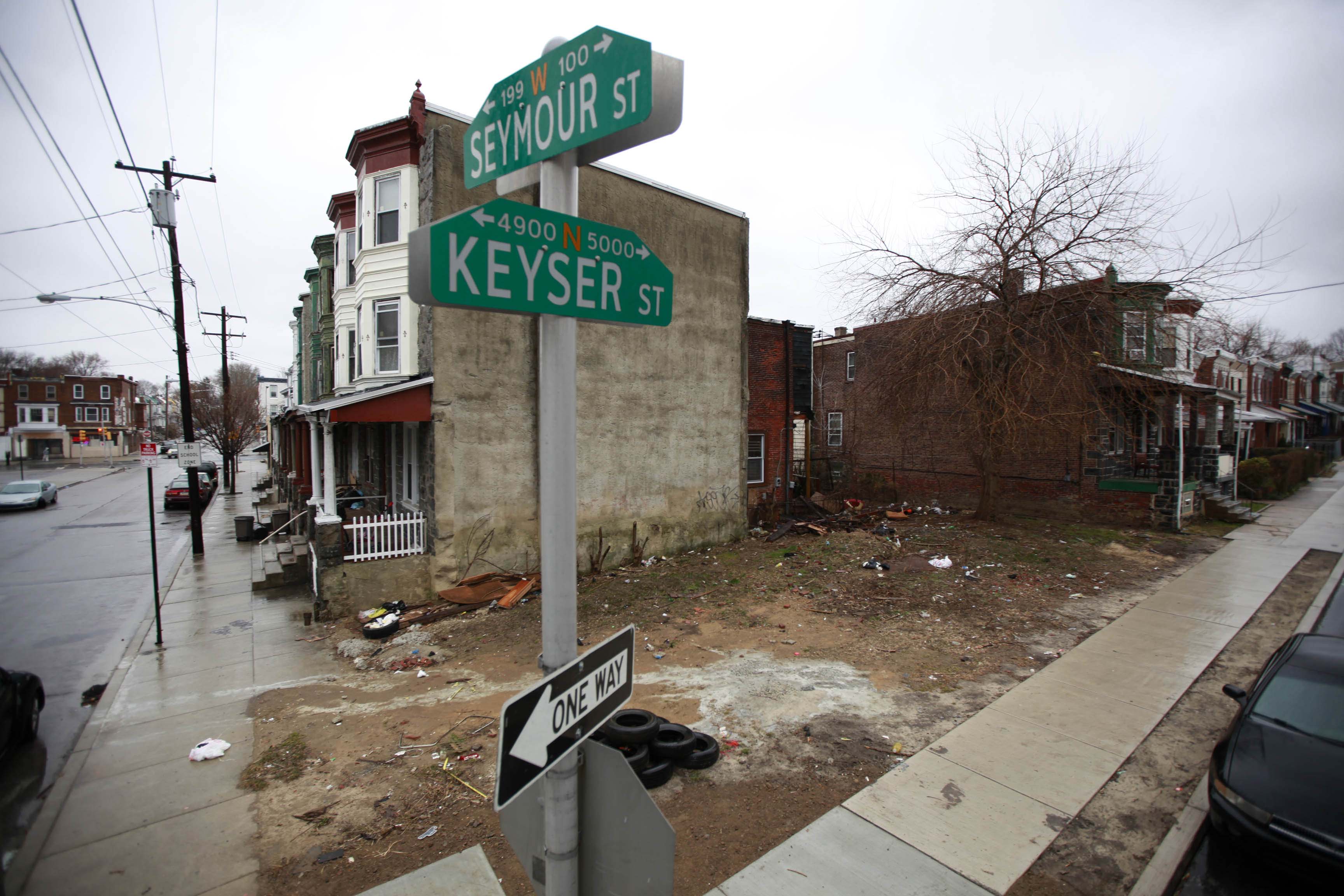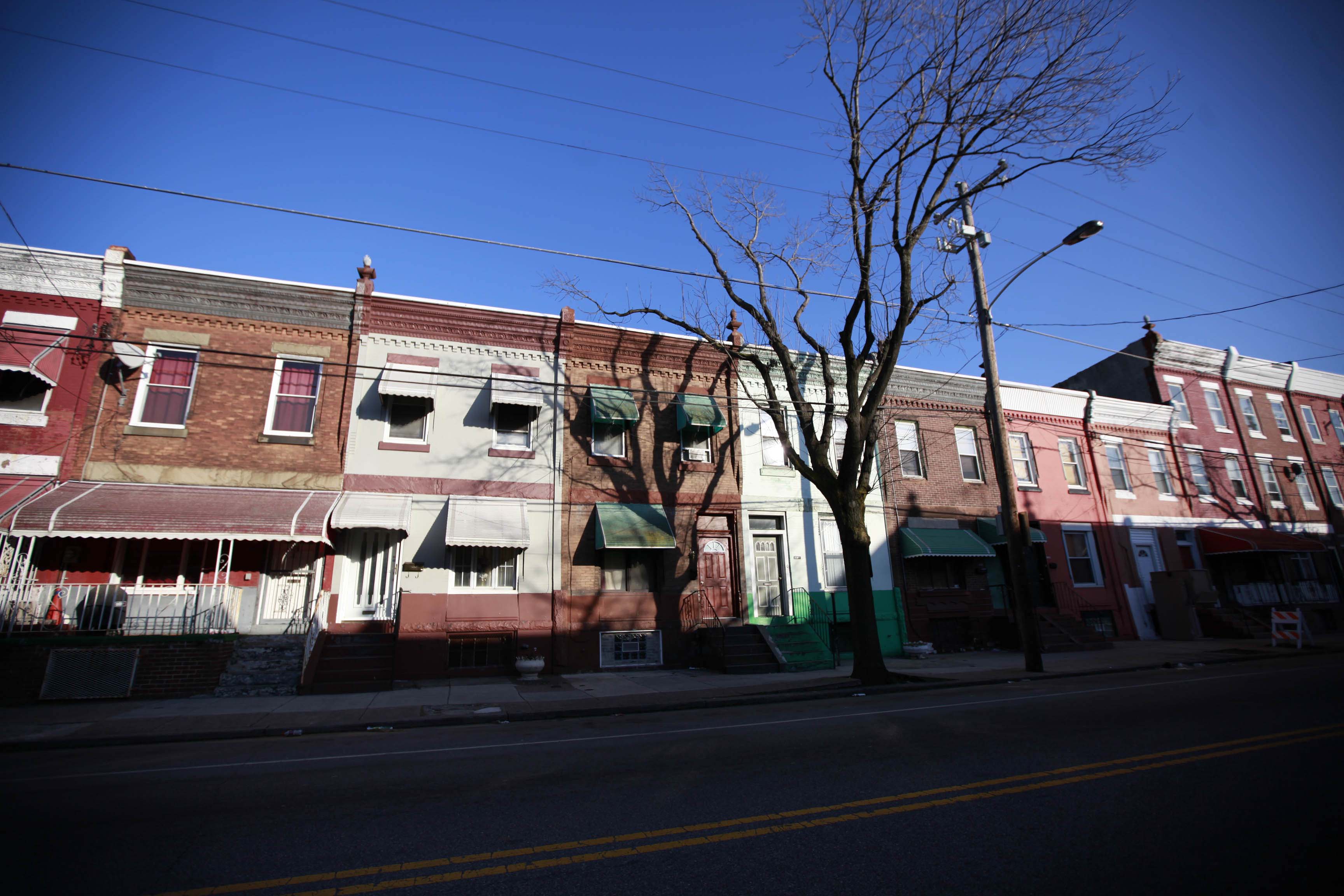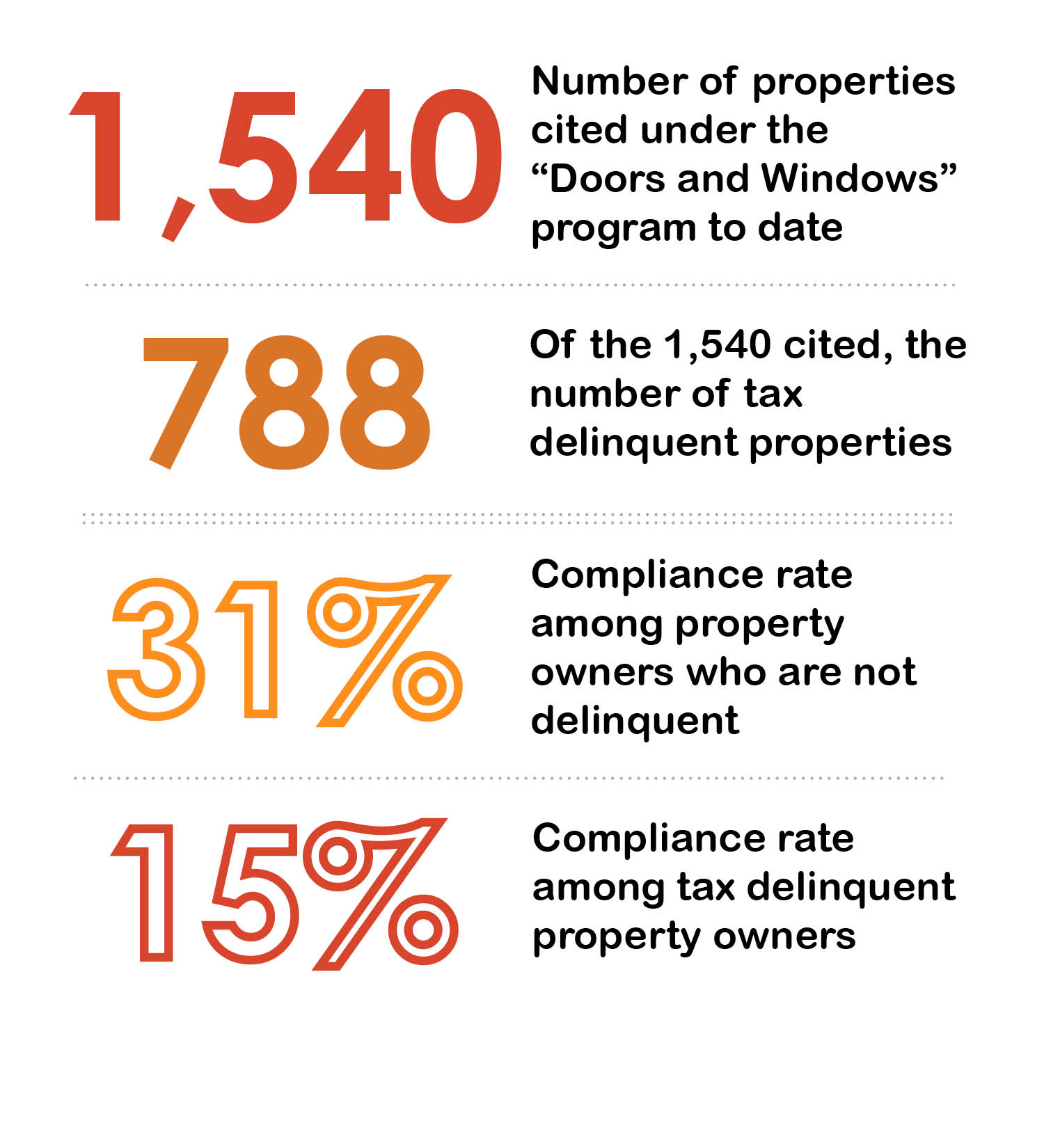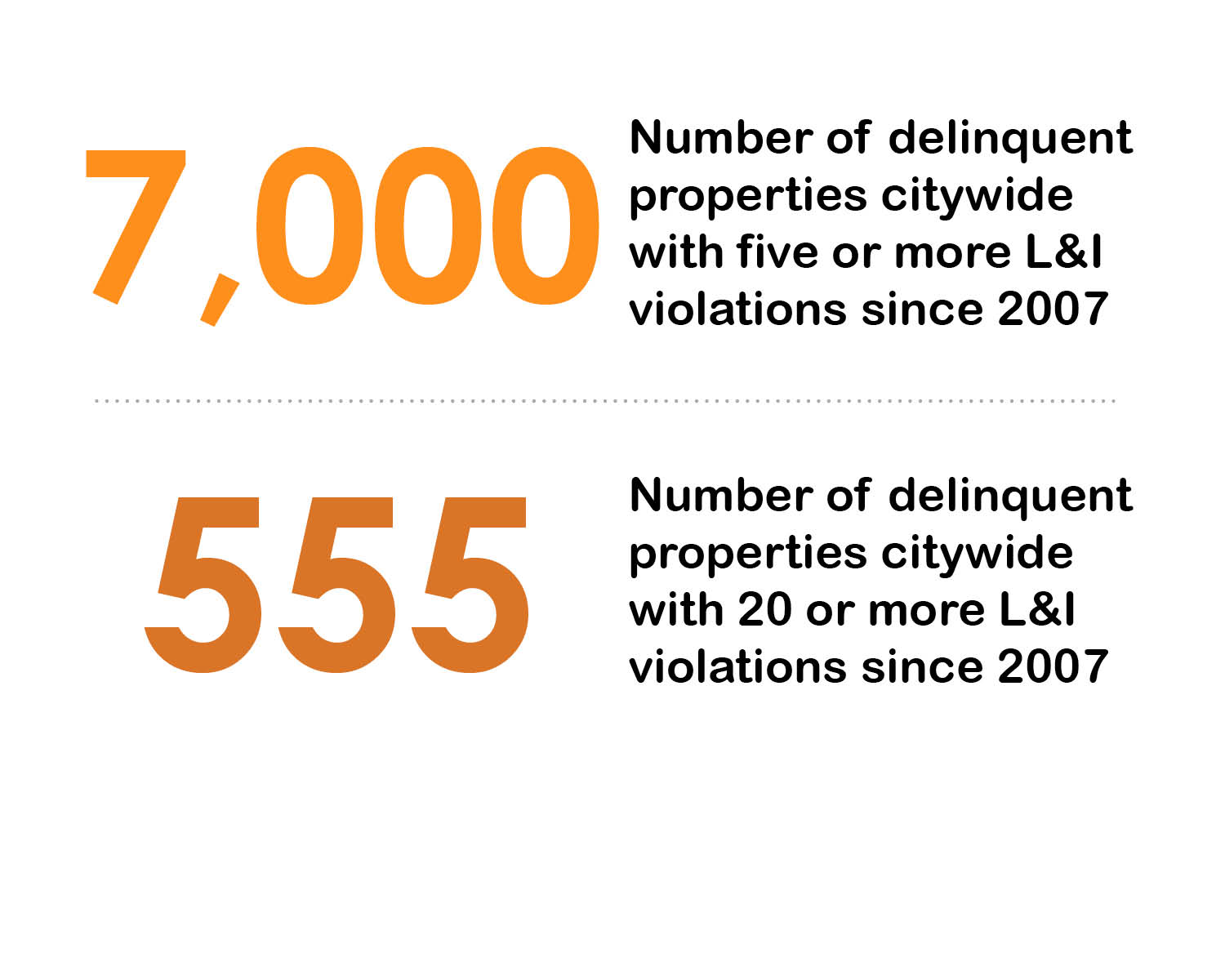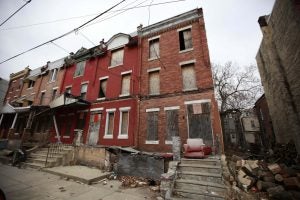Part One: Lax property tax enforcement and brazen deadbeat investors have depressed Philadelphia’s property-tax base by $9.5 billion
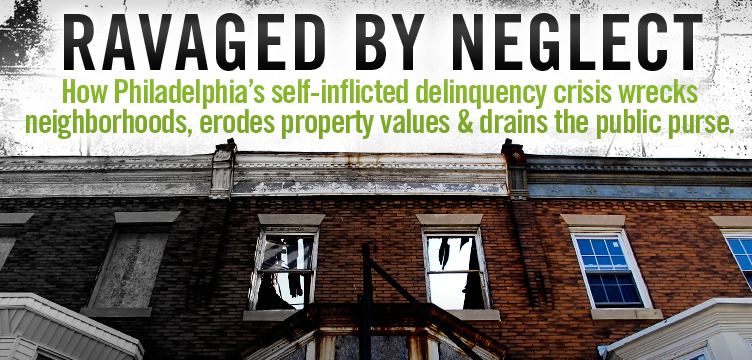
The neighbors did what they could to dress up the gaping wound on their block. They painted the steps black and the porch a bold bluish-green. In the fall, they put a pot of mums out front.
But cosmetic touches only do so much for an abandoned shell of a house with sheet metal for windows and a slab of plywood for a door.
This wreck in the working-class 4400 block of North Orianna Street in the city’s Hunting Park section is just one of about 100,000 tax-delinquent properties in Philadelphia, a $5,780 drop in a half-billion-dollar bucket of defaulted payments to the city and school district.
Almost anywhere else in the nation, the listed owner of this husk of a house – a seemingly defunct, Main Line-based, property-holding company – would have long since been forced to pay up or lose the lot at sheriff’s sale. But in Philadelphia, holding owners accountable for delinquent property like this decrepit two-story rowhouse on a block with dozens of children has not been a priority.
For the roofers and substitute teachers who make their homes on the 4400 block of Orianna, the failure to enforce tax law has diminished both quality of life and property values. That single ruinous, tax-delinquent house has lowered the value of the homes within 500 feet by a total of $38,000, a new analysis finds. When the effects of other nearby delinquents are piled on, the total hit to the value of these working-class homes approaches 40 percent, lowering their worth to about $55,000 apiece.
For Philadelphia as a whole, city government’s decades-old practice of neglect has been even more disastrous.
A year-long PlanPhilly/Inquirer investigation into the city’s real-estate tax enforcement system and a professional economic analysis of property data has found that mass delinquency cripples the tax base, erodes the home equity of hundreds of thousands of owners, and starves both City Hall and the school district of badly needed funds.
The investigation and analysis found that:
- Delinquency depresses the overall property-tax base by at least $9.5 billion, a staggering sum that represents almost 10 percent of the city’s $98.5 billion in taxable real estate.
- On average, single-family homes are worth 22.8 percent less on the open market than they would be if they had no delinquent neighbors.
- If delinquency was eliminated – a goal that most U.S. cities approach and some cities achieve on a regular basis – the tax revenue generated by a healthier tax base could be as much as $298 million a year.
- Some delinquent properties are owned by low-income homeowners who genuinely lack the means to pay. But most are not. At least 59 percent of all delinquent real estate in Philadelphia belongs to landlords, speculators and investors who do not live at the delinquent properties they own.
- Delinquent properties are voracious consumers of scarce city resources and prodigious generators of blight, accounting for far more than their share of taxpayer-funded demolitions, code violations and court hearings.
- Very few neighborhoods are immune to the effects of delinquency. Ninety-six percent of all single-family homes have lost property value because of nearby delinquents.
- Despite these effects, tax delinquency has received little sustained attention from most administrations for at least the past few decades. Mayors have, on occasion, announced initiatives promising to crack down on the largest of deadbeats. But none of these programs have dealt a serious blow to the problem.
_______________________________________________________________________________________________________________________________
_______________________________________________________________________________________________________________________________
Increasingly, though, Philadelphians are focusing on both real estate taxes and the legions of property owners who do not pay what they owe. The transition this year to a new assessment system – the Actual Value Initiative – will raise taxes on a majority of the city’s 457,000 residential properties, while as many as 30,000, or 6.6 percent, could receive bills that are triple or more than what they had been charged under the old system.
In that context, the abundance of tax dodgers has become a political liability for both City Council and Mayor Nutter, who are considering a wide array of new tax collection measures.
At a press conference last month, the mayor called delinquents who could afford to pay and did not “trifling, raggedy people” and warned that the city would “chase their little asses down as far as possible.”
Nutter pledged a $40 million investment in delinquency enforcement over the next five years, including $25 million on new technology and $15 million on new staff. He predicted the effort would yield additional collections of $260 million over the next five years.
The mayor would not grant an interview for this story. City officials did provide written responses to 30 of 47 questions – most answers vigorously defended the administration’s record on tax delinquency.
“Since the beginning of our administration, we have worked diligently to improve our delinquent tax collection efforts,” Nutter said at the news conference, ticking off initiatives such as a crackdown on tax-delinquent city workers and a tax amnesty program.
“We’re certainly pleased with the outcomes of the strategies,” he said, “but we know clearly there is much more that we can do, must do, and will do to collect on delinquent taxes and to ensure fairness for every citizen.”
The problem in Philadelphia, Nutter said, is that too many property owners short City Hall and the school district, while making good on other debts. “They pay the federal government. They pay the state government. They pay the phone company. They pay a whole lot of folks, but they’re not paying us, and we’re not going to stand for it anymore.”
But there’s a reason property tax delinquents feel free to ignore collection notices from the city. Philadelphia’s property-tax enforcement system is arguably the most permissive in the nation, routinely tolerating chronic delinquency on a scale that is unheard of anywhere but economically ravaged Detroit, experts said. Of the 100,000 tax-delinquent parcels, about 40,000 have been delinquent for six or more years.
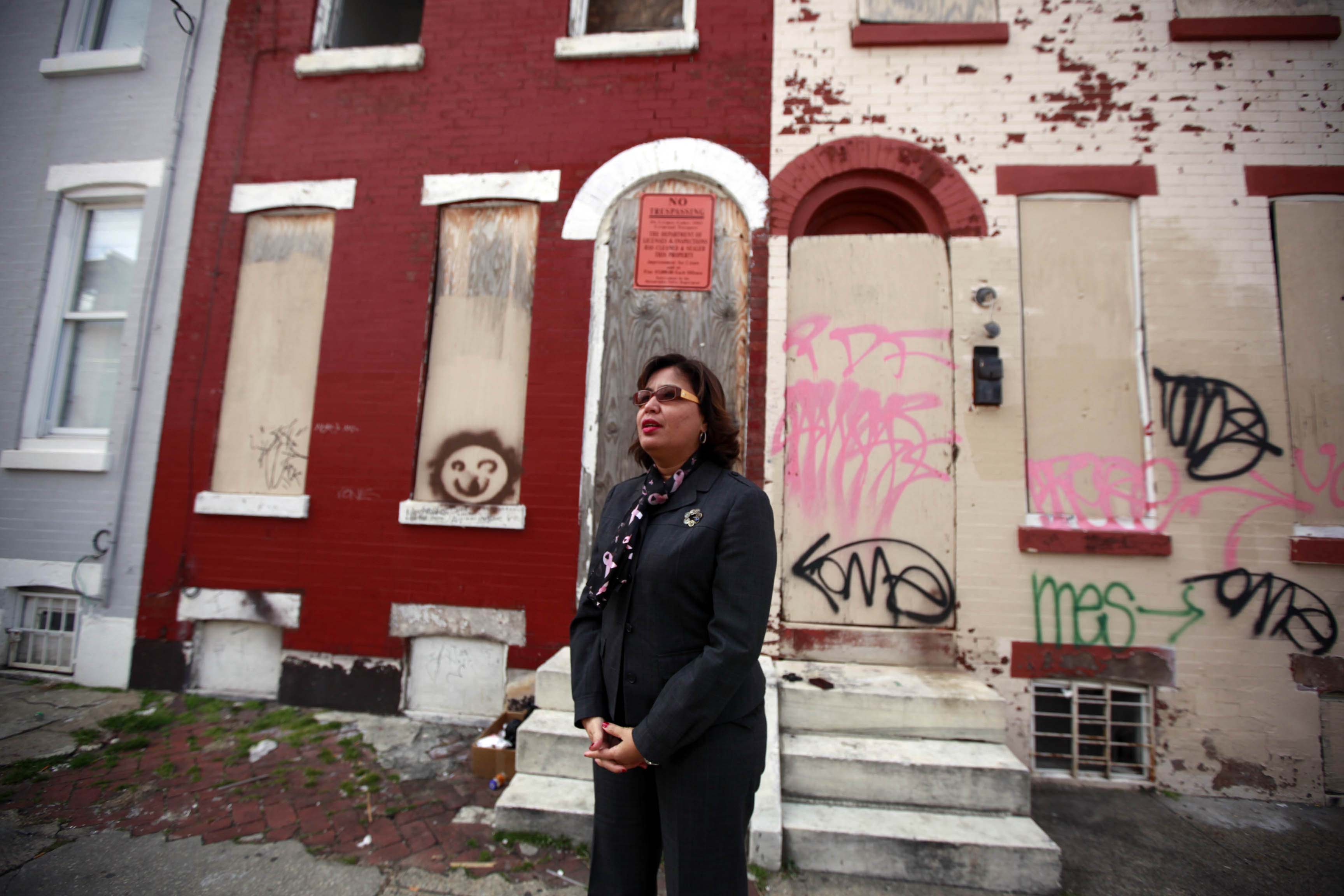
“If people understood how these speculators, these delinquents, devalued their homes, they’d be outraged,” said Councilwoman Maria Quiñones-Sánchez, whose district in North Philadelphia is rife with blighted properties and vacant land.
“It’s like watching somebody take money from your pocket. And we, the city, have just stood by and watched it happen.”
On average, other large U.S. cities collect 95 percent of what they are owed in property taxes the same year those taxes are due. The average collection rate climbs to 99 percent in subsequent years, when enforcement measures – up to and often including the auctioning off of tax delinquent property – kick in.
Philadelphia consistently comes in well below those rates. Since Nutter took office, the city’s average annual collection rate has been 85.6 percent, 10 percentage points below the average rate of the 20 largest cities over the same period.
The cash lost from the below-average collection rate is tough to take, given that Philadelphia has raised property taxes three consecutive years and funds a school district that voted Thursday to shutter 23 schools.
If Philadelphia could match the collection rate of other cities, it would immediately net an additional $20.4 million for the city budget and $25.9 million for the school district – a figure that is slightly larger than the $24.5 million the district hopes it will save annually through the planned school closings.
“There are real consequences for all of this,” said education activist Helen Gym. “It means a child with asthma doesn’t get a nurse in their school. It means schools can’t get basic repairs done when they need to be done. It means we can’t prioritize safety issues like we should.”
Gym added, “It’s infuriating that children have to pay for the consequences of the city’s neglect, that kids have to pay for this culture of delinquency that infects our city and that our leadership has tolerated.”
It is not just public school children who pay the price for Philadelphia’s delinquency crisis. The full costs of mass delinquency do not easily show up on any balance sheet, but they are no less real. Indeed, those costs are involuntarily borne by all Philadelphians – by the homeowners who lose equity, by the neighbors who cope with the crime and filth that abandoned homes, factories and warehouses breed, by the city departments charged with cleaning up the messes that problem properties create, and by the taxpayers who pay more because delinquents pay none.
“THERE’S GOT TO BE A LAW”
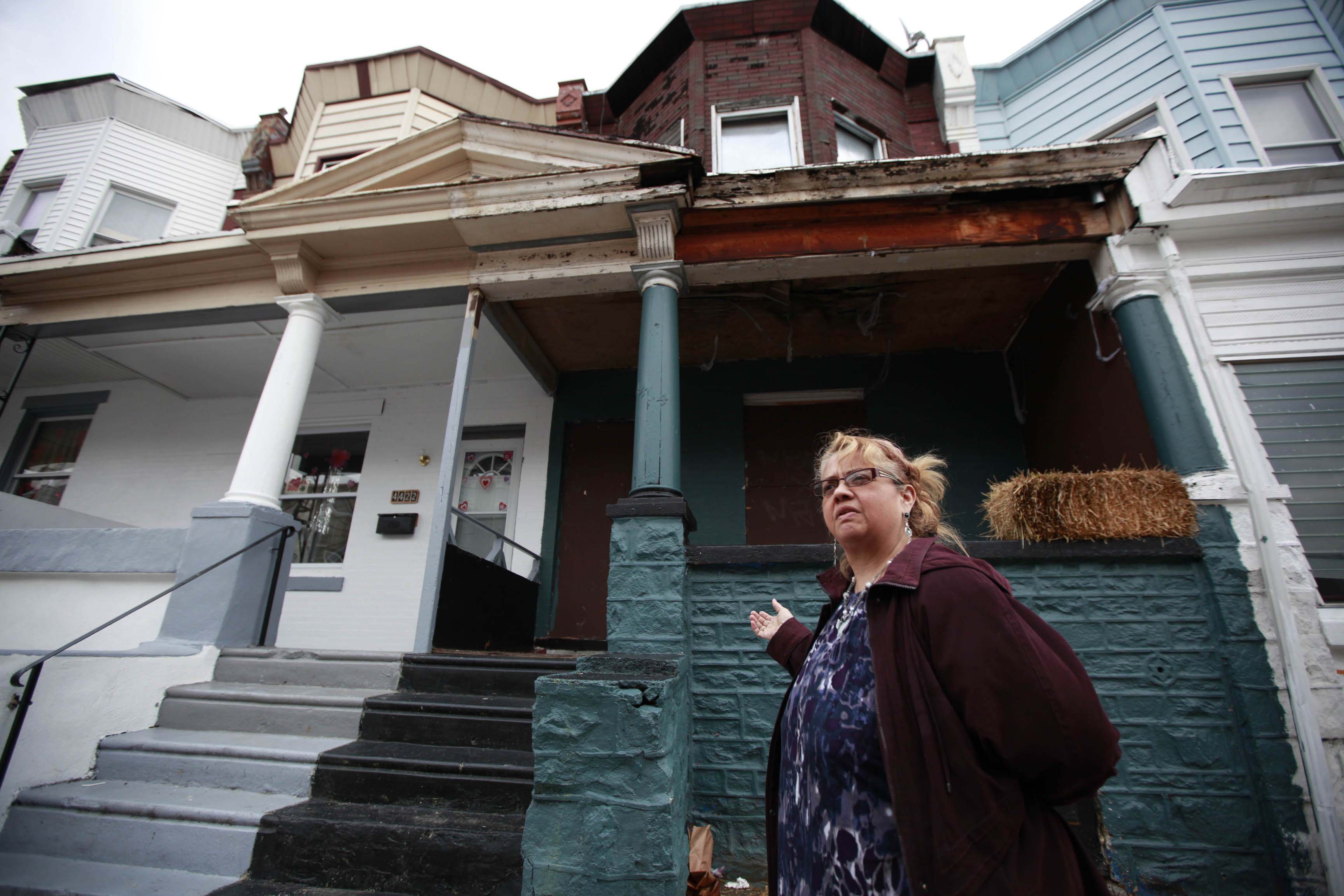
In many ways, the story of the 4400 block of North Orianna Street is a good one. Over the last year, this unusually diverse collection of neighbors has banded together to push the pushers out, to paint and tidy their own homes, even to enter a city-sponsored clean block contest.
It remains a low-income block, but it is also, increasingly, a vibrant and healthy one. All but one of the houses is occupied.
On a recent winter afternoon, four older children were playing in the street while their parents peeked outside every few minutes to check on them.
Roofers were laying new asphalt tiles on one of the rowhouses, a fresh sign that many of the property owners are investing money and toil in the 78-year-old buildings.
But the shell at 4424 is a hideous pustule the block just can’t get rid of.
It was abandoned years ago – neighbors can’t remember exactly when. But they do recall the drug dealers who felt so comfortable doing business from the building that they placed couches on the porch. And they say the garbage-filled backyard – which smells powerfully of something rotten – has attracted rats and other pests for at least five years.
Neighbors have repeatedly called Licenses and Inspections, and the agency has dutifully cited the property’s owner eight times in the last seven years, to little avail. The house is still vacant and horribly unkempt. It is also tax delinquent: six years in arrears, and $5,780 in debt to the city.
“This sort of house, this is what causes fires, this is what makes the drug dealers think they own the neighborhood, this is how you get squatters,” said Luisa Baerga, a dynamo of a block captain who lives across the street from the vacant rowhouse.
Who is responsible? The public record shows it is a company called Mercury Group, which, with associated entities, owns at least 22 other tax-delinquent properties in Philadelphia, according to public records.
Together, the company’s holdings are 128 years delinquent and $138,000 behind in their payments to the city and school district.
By all appearances, Mercury Group no longer exists. The company is no longer at its state-registered office address, and the private address associated with the company’s owner leads to a Wynnewood shopping center where the other tenants had no knowledge of the owner or Mercury Group. There is a UPS Store in the shopping center, but employees said nobody rents the mailbox that matches the address Mercury Group’s owner listed as his unit number.
“How does someone get away with this?” Baerga asked. “There’s got to be a law.”
There is a law.
Pennsylvania’s Municipal Claims and Tax Lien Law, last amended in 1992, instructs Philadelphia to “proceed on tax claims after one year of delinquency, unless the owner or an interested party enters into a payment agreement.” That language was added specifically to speed the city’s processing of tax delinquent properties, said Andy Toy, an economic development specialist who was working for the city at the time and helped to draft the amendment.
“The city simply didn’t follow through on a lot of what the amendments said to do,” Toy said.
In most cities and municipalities, comparable language has been interpreted to mean that property-tax delinquents – particularly those who are not owner-occupants – have a limited time to make good on their debts before losing their property at sheriff’s sale.
But Philadelphia has interpreted the statutory language far more loosely. Many long-term tax delinquent properties, including 4424 N. Orianna, have never been sued by the city for property tax delinquency.
For homeowners, that practice has been a costly one.
EQUITY LOST
On the carefully maintained 3600 block of Almond Street in Port Richmond, delinquents sap the neighborhood of 13 percent of its value.
For residents of the tree-lined 4700 block of Cedar Avenue, the lost-equity tab is 11 percent.
On Germantown’s Keyser Street, homes are worth 32 percent less than they would be if the city eliminated tax delinquency.
And in Strawberry Mansion, where the delinquents tend to be not just irresponsible property owners, but the sort who have utterly abandoned the land they own, endemic delinquency drains the value of homes on the 1500 block of North 29th Street by a knee-buckling 60 percent.
This correlation between depressed property values and delinquency was confirmed in an independent analysis conducted by Kevin Gillen, an economist and senior research consultant at the University of Pennsylvania’s Fels Institute of Government. Gillen is considered the region’s foremost expert on property values. The city has retained Gillen as a consultant many times, and his work played a central role in the Actual Value Initiative.
PlanPhilly hired Gillen to explore what impact, if any, delinquency has on the property values of single-family homes. Using a model known as “hybrid hedonic regression,” Gillen isolated the effect delinquencies have on property values, filtering out other factors that help determine pricing, such as square footage, lot size and proximity to amenities such as transit, parks and Center City.
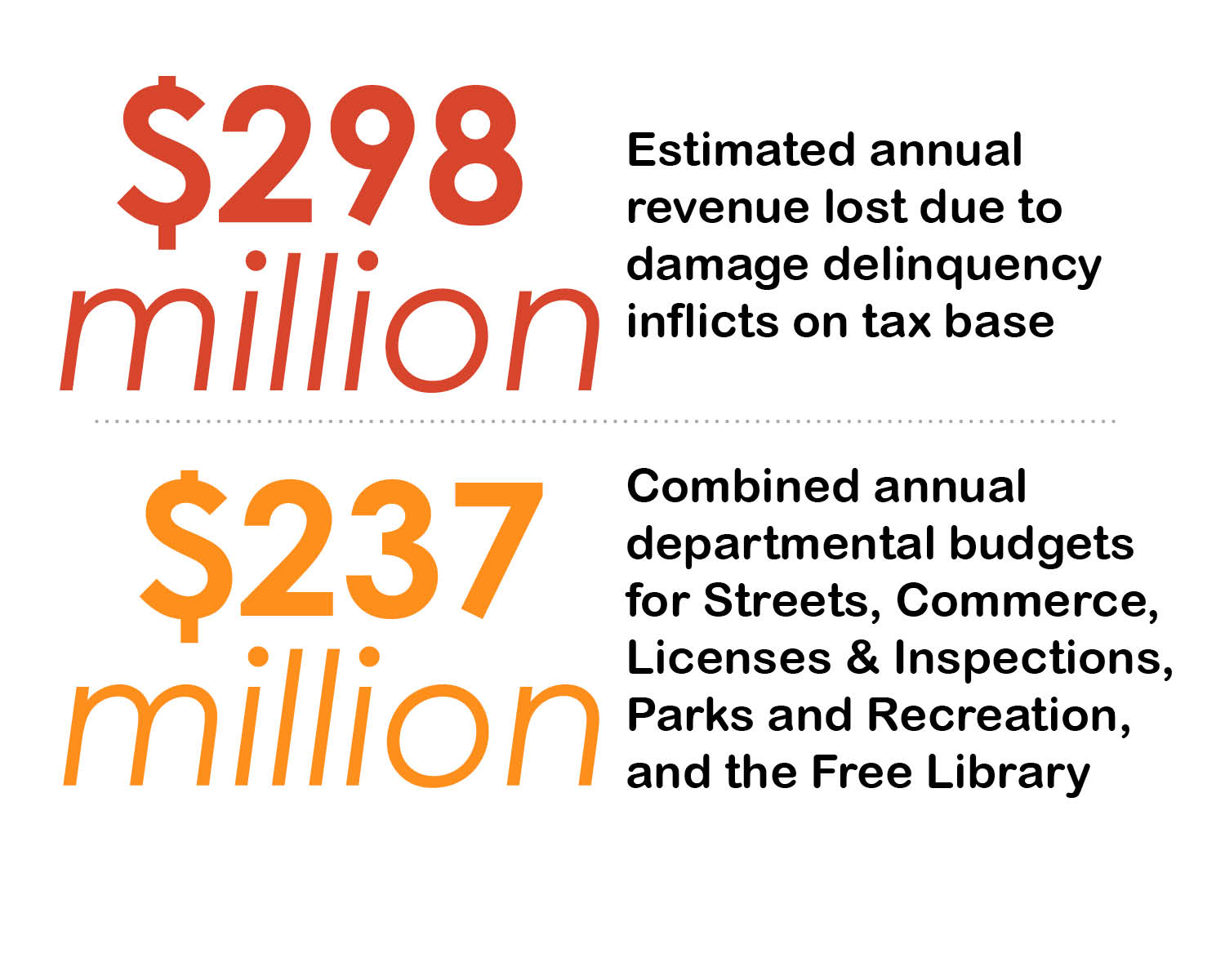
Gillen’s findings suggest that the $515 million that deadbeats owe the city in unpaid tax bills is mere pocket change when compared to the true tab of delinquency. In all, delinquency deflates the value of Philadelphia’s single-family housing stock by $9.5 billion. It is a crippling blow, costing the city and school district as much as $298 million a year in revenue.
That amount would cover the annual budgets of the city’s library system, the parks and recreation network, and the Departments of Streets, Licenses and Inspections, and Commerce – with $61 million to spare. If the $298 million were allocated to the school district annually, its structural deficit would be eliminated.
Or, the added revenue and a healthier, delinquency-free tax base could enable City Council to lower the overall post-AVI tax rate by 0.12 percentage points – an amount equal to $120 for every $100,000 of a property’s assessed value – while collecting just as much cash as the city does today.
Wiping out delinquency would have enormous benefits for homeowners as well.
Endemic delinquency depletes the market value of single family homes with deadbeat neighbors by an average of $22,800 each, or 22.8 percent, Gillen’s analysis found. Which means that tax deadbeats – and the weak city enforcement system that enables them – are depriving hundreds of thousands of tax-paying Philadelphians of substantial equity in their homes.
For a relative handful of property owners, delinquency’s impact is mild or non-existent. For others, delinquency demolishes property value.
The effect depends on the number of delinquent parcels within 500 feet of the home. Fewer than five, and the delinquencies do only negligible damage to home values. Five or more, however, and delinquency begins to drain values quickly.
Consider a home with a market value of $230,000 (the median value of Philadelphia homes on blocks where delinquency has no effect). The presence of five delinquent properties within 500 feet deflates the value of that home by $2,500. Ten delinquencies take $14,600 off the value. At 15 delinquencies within 500 feet, the home loses $24,800, or 10.8 percent, of its value.
Each additional delinquency takes a further toll, but the effect tapers off as delinquency becomes endemic: the neighborhood is already lost, so the addition of one more deadbeat property makes little difference.
City Finance Director Rob Dubow questioned Gillen’s findings.
“While we are taking tax delinquency very seriously, I believe there’s a false premise at work here,” he wrote in an email. “I fundamentally am not convinced that there is a causal nexus between tax delinquency and a reduction in property values. Correlation is quite different from causation.”
Dubow, who received a copy of Gillen’s analysis on Jan. 28. did not elaborate. Gillen agreed that “correlation and causation are not the same thing, which is why from the very beginning of this project I took great care to develop an empirical strategy that actively endeavored to disentangle the two.”
Gillen said his methodology accounts for the fact that delinquency is “already likely to occur in relatively depressed or declining neighborhoods.” Even after doing so, however, he found that “additional delinquencies often amplify and accelerate the rate of economic and physical decline of these same neighborhoods.”
The problem is that by tolerating delinquency, the city has sent a message to property owners that “it’s OK to sit on a property, it’s OK to let it deteriorate, there are no consequences,” said Sam Katz, chairman of the Pennsylvania Intergovernmental Cooperation Authority, which has oversight over Philadelphia’s long-term fiscal planning.
Katz likens property-tax delinquency to the “broken windows” theory: left unchecked, vandalism and minor crimes lead to more serious crimes.
Gillen’s analysis points the way to possible fixes.
By focusing its resources on neighborhoods that have not yet slipped into mass delinquency, the city could do the most good, most quickly, Gillen said.
“It doesn’t need to solve the delinquency problem everywhere at once,” Gillen said. “The city can get big gains by targeting those working-class to lower-middle-class neighborhoods that are on that fine line between becoming revitalized, strong neighborhoods, or slipping into very-low-income neighborhoods with very distressed housing stocks.”
SUPER BLIGHTERS
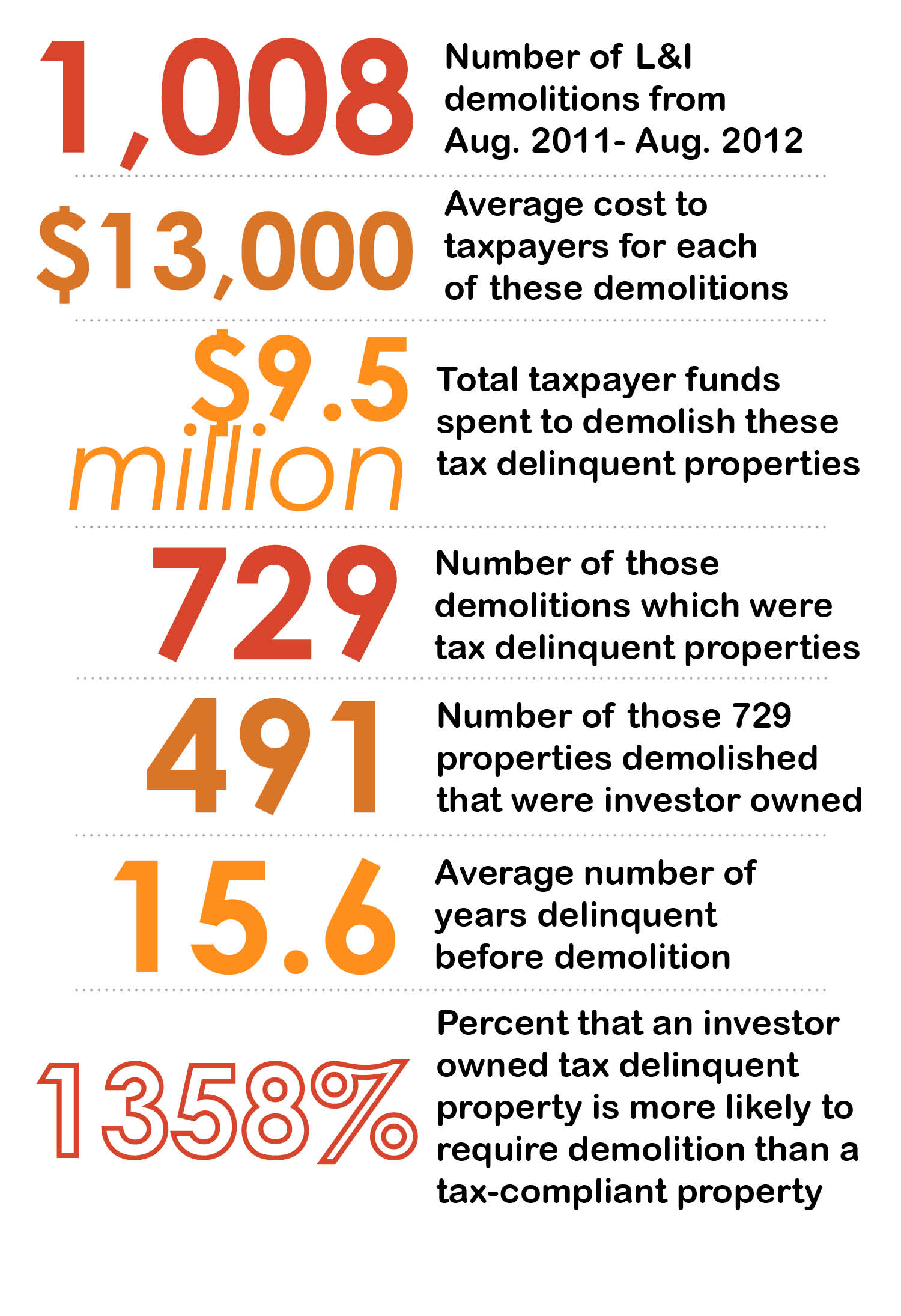
Distressed housing and delinquency go hand in hand.
While there are thousands of exceptions – mostly low-income owner-occupants who are behind on their taxes yet still committed to maintaining their homes – delinquents are, as a class, a major blighting influence on communities of all kinds.
A detailed examination of a year’s worth of violations issued by the city Department of Licenses and Inspections from Aug. 22, 2011 through Aug. 16, 2012 revealed that tax-delinquent properties rack up hugely disproportionate numbers of code citations. The worst offenders are those tax-delinquent properties owned by investors, speculators and landlords, instead of owner-occupants.
During that period, the city tore down 1,008 imminently dangerous properties, at an average cost to taxpayers of $13,000 apiece. Of those demolitions, 729 properties were tax delinquent, with 491 of those properties investor owned. In that year, investor-owned, tax-delinquent properties were 13 times more likely to require L&I demolitions due to unsafe conditions than were tax-compliant properties.
Taxpayers spent $9.5 million over that period tearing down those blighted and dangerous structures owned by tax delinquents. Had the city foreclosed on those delinquent parcels and found new owners at sheriff’s sales, that expense could have been reduced, if not eliminated.
There would seem to have been plenty of time for a functioning enforcement system to do its job: the demolished structures had been delinquent for an average of 15.6 years when the taxpayer-funded bulldozers were called in.
The PlanPhilly/Inquirer review further found that:
- Investor-owned tax delinquent property is nearly seven times more likely to be hit with a vacancy violation than tax-compliant property.
- Investor-owned delinquent parcels are three times more likely to be cited for property maintenance violations than are tax-compliant properties.
- There were 20,854 quality-of-life violations (including demolitions, property maintenance and vacancy license violations) issued to just 3,461 properties. Put another way, slightly more than one-half of 1 percent of all properties in Philadelphia received 38 percent of the total quality-of-life violations issued in that year. Of those super blighters, nearly half were delinquent.
These are properties such as 3808 Cambridge St. in East Parkside, a neighborhood near the Philadelphia Zoo. Working-class rowhouses dominate the block, but boarded-up, delinquent wrecks like 3808 Cambridge are a growing challenge.
That parcel has been delinquent for 15 years, owes $10,618 in property taxes, and has been cited for 16 violations since 2007 – for everything from rodent infestation and high weeds to unsecured doors and windows – and inspectors have visited the property at least seven times since then.
Nobody lives at 3808 Cambridge. Its registered owner is an entity called CTDS Property LLC, with a billing address in Penndel, Bucks County. The city sued CTDS for an unpaid gas bill for that address, but it has taken no steps in court to foreclose on the property for non-payment of taxes.
Or consider 1822 Waterloo St., in West Kensington, a vacant rowhouse with a bulging brick facade. L&I has cited the property 11 times since 2007 to get the owners – listed as County Management Services, with a mailing address on Academy Road in the Far Northeast – to slap some plywood over the windows. That property is eight-years’ delinquent and owes $5,586, according to city records.
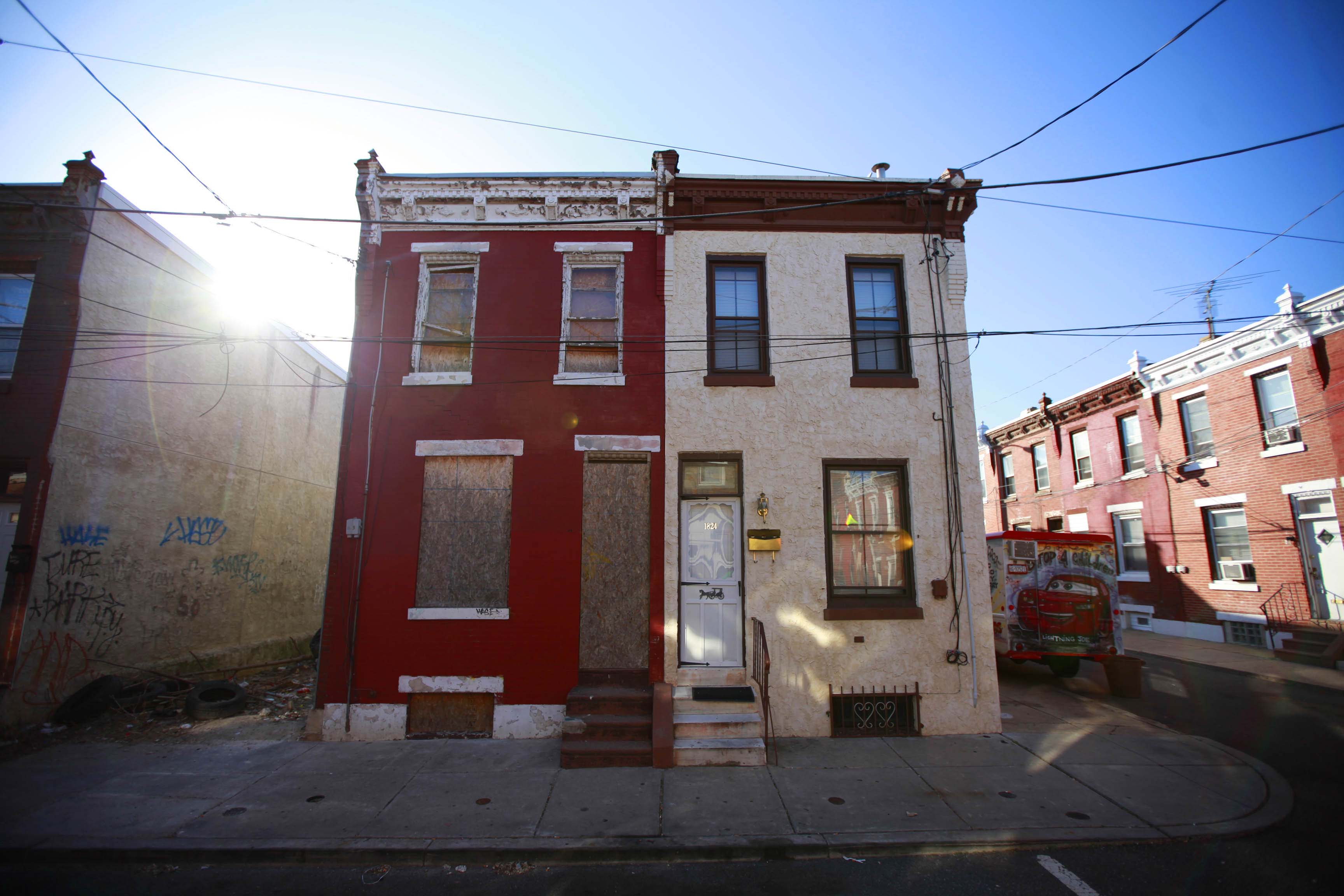
Neither of these properties is the least bit remarkable. Indeed, there are more than 7,000 tax-delinquent properties citywide that have received five or more L&I violations since 2007, and 555 delinquent parcels with 20 or more violations in that period.
Nor are these sorts of delinquent blighters confined to derelict blocks. One of the Nutter administration’s more successful blight-fighting initiatives has been the “doors and windows” program, which requires owners of vacant residential property to use real doors and windows on their empty buildings, instead of plywood or other half-measures, when the block is at least 80 percent occupied. The objective is to prevent threatened blocks from slipping into total disrepair.
Of the 1,540 properties cited under the program, 788 were tax delinquent.
“When you see high correlations between code violations and delinquency, it just confirms that the owner has chosen to abandon, or to at least disinvest from, their property,” said Frank Alexander, a law professor at Emory University and a national expert on real-estate tax delinquency. “Which raises a question: Why is that tolerated at all? Why is it permitted for any property at all to remain tax delinquent and with code violations?”
As complex as property taxation and code enforcement can be, the “issue at bottom is very simple,” Alexander said. “Communities need to say to the owners of delinquent, substandard property: ‘Either fix it up and pay it up, or give it up.’”
_______________________________________________________________________________________________________________________________
Coming Monday: Who’s to blame? A profile of the delinquents, and the neighborhoods they damage.
Coming Tuesday: Enabling the deadbeats. An investigation of the city’s failings, and some potential fixes.
About This Series:
Patrick Kerkstra has spent years exploring Philadelphia’s property tax crisis. For this collaborative effort between thePhiladelphia Inquirer, PlanPhilly and AxisPhilly, he interviewed property owners, city officials and redevelopment experts and analyzed millions of records in the city’s property, delinquency, billing and code violation databases. That reporting was complemented by a professional economic analysis of delinquency’s impact on property values by Kevin Gillen, PhD, a Fels School of Government economist and the region’s leading property values expert (read his complete study, and methodology). Inquirer editors, photographers and designers produced the package, and PlanPhilly journalists Jared Brey and Ashley Hahn provided significant reportorial contributions. The project was made possible through funding by the William Penn Foundation. Contributors include AxisPhilly‘s news application editor, Casey Thomas, researchers Evan Croen, James Robertson and John Dailey and designer John Suvannavejh.
PlanPhilly.com is an alternative media news website that covers design, planning and development issues in Philadelphia. AxisPhilly is a non-profit news and information organization which educates and engages citizens on topics of public interest.
WHYY is your source for fact-based, in-depth journalism and information. As a nonprofit organization, we rely on financial support from readers like you. Please give today.



